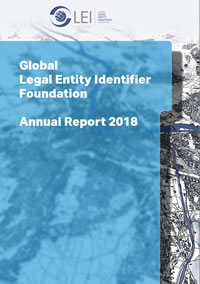For all media enquiries: info@portalchemy.com
5th February 2019, Brighton
 We're glad to announce our co-operation with XBRL International and Gleif in producing the next Gleif annual report for the year 2019. We shall be using Onedit to convert the InDesign artwork into XHTML and are working very closely with Gleif's design agency based in Frankfurt to achieve optimal document preparation.
We're glad to announce our co-operation with XBRL International and Gleif in producing the next Gleif annual report for the year 2019. We shall be using Onedit to convert the InDesign artwork into XHTML and are working very closely with Gleif's design agency based in Frankfurt to achieve optimal document preparation.
We are also expecting to use our 'Onetag' auto suggestion AI which is now being trained in other major European languages.
Ian Whitworth says "This is an exciting time as we start to use our technologies for the iXBRL process. We have had a pure XHTML workflow for over 10 years that can could already produce high fidelity designed documents. The last three years has been about adding XBRL capability to our workflow and we are now in a position to create a single instance file within our iXBRL reader that is on the surface as good as a PDF but offering all the further 'graphical' and other benefits of the XBRL taxonomy."
Established by the Financial Stability Board in June 2014, the Global Legal Entity Identifier Foundation (GLEIF) is tasked to support the implementation and use of the Legal Entity Identifier (LEI). The foundation is backed and overseen by the LEI Regulatory Oversight Committee, representing public authorities from around the globe that have come together to jointly drive forward transparency within the global financial markets. GLEIF is a supra-national not-for-profit organization headquartered in Basel, Switzerland.
GLEIF makes available the Global LEI Index; i.e. the only global online source that provides open, standardized and high quality legal entity reference data. By doing so, GLEIF enables people and businesses to make smarter, less costly and more reliable decisions about who to do business with.
The Legal Entity Identifier (LEI) is a 20-character, alpha-numeric code based on the ISO 17442 standard developed by the International Organization for Standardization (ISO). It connects to key reference information that enables clear and unique identification of legal entities participating in financial transactions. Each LEI contains information about an entity’s ownership structure and thus answers the questions of 'who is who’ and ‘who owns whom’. Simply put, the publicly available LEI data pool can be regarded as a global directory, which greatly enhances transparency in the global marketplace.
For more information: info@portalchemy.com
12th November 2018, Dubai
Ian Whitworth presented the issues that face European design industry in the light of the regulatory changes. He unpicked the present annual report suppliers citing the fact that the use of InDesign has prevented innovation and led to agencies being less data centric than they should be. He gave a brief history of the (UK) html rollercoaster story and went on to present Onedit, PortAlchemy solution to iXBRL workflow.
"For us at PortAlchemy iXBRL represents an opportunity to create not only a new design format, an opportunity that rarely comes along, but also create an exciting new visual medium based on iXBRL and its relationship to the narrative and storytelling.
The challenge for designers is to understand ‘the art of the possible’ and embrace the medium of iXBRL and transform that into a communication channel with super charged graphics and connectivity.
The challenge for software vendors is to create APIs that allow the fluency necessary to create exciting graphics and Onedit has been on that journey for a number of years now.
The challenge for issuers is to leverage the opportunity and realise the benefits of iXBRL rather than just viewing at as a compliancy exercise."
In his presentation, Ian Whitworth, founder of PortAlchemy, made the astute observation that the user is as important as the regulator – and that we need to be thinking about how best structured data meets document design. As a graphic designer and programmer he has built a multiuser web-based design tool for annual report creation that can replace or work with the designer’s tool of choice – Adobe’s InDesign.
With ESEF commencing in 2020 – which will affect highly designed financial statements - this is the perfect time to develop more design-led iXBRL capabilities.
Although tools like the open source Inline viewer (referred to below) have been designed very much with regulators in mind, Ian points out that highly designed Inline XBRL disclosures can be made more interactive on corporate websites using similar tools. That leads to interesting opportunities for marketing and investor relations. For example, a company could provide dynamic performance graphs driven by the information contained in the Inline XBRL annual financial report. Standard – cookie driven – analysis systems could then help the investor relations team to understand what users are most interested in.
Efforts like this may well prove a way to align the interests and outputs of corporate reporting teams with their colleagues focussed on investor relations.
For more information: info@portalchemy.com

© PortAlchemy 2021